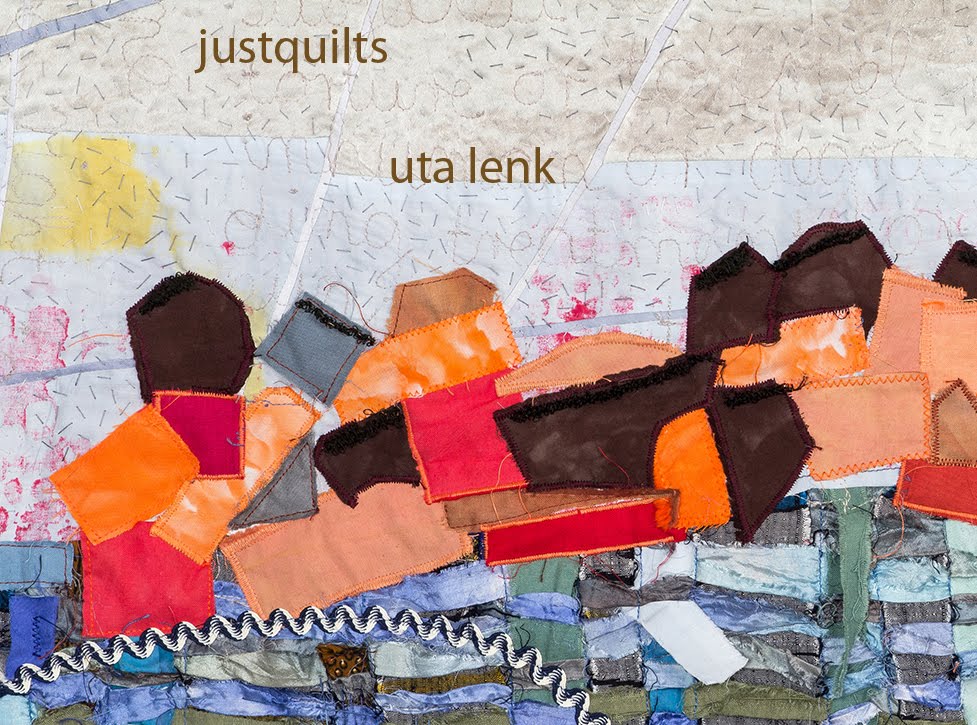After posting yesterday I spent a long time during which I couldn’t go to sleep because I kept thinking about the whole matter of pictorial quilts, quilts in the art world, art in the quilting world, women in art etc.
This morning I talked to an friend of mine who is a goldsmith by training, and an artist – graduate of Munich Art School – and she pointed out to me that goldsmiths/jewellers face the same problem. Jewellery has a hard time being recognized as art, because it is considered decorative, a craft.
We both agreed on that it all boils down to the question of „what is art?“ What is the line that separates some kind of self-expression from art.
For example, when you see the following picture and know that it was drawn by a five-year-old boy, you would probably not consider it to be 'art':
However, if it bore a different signature, say 'Picasso', you might assume it to be an unknown picture dating from his blue period. (Far-fetched, I know, but let's just assume.)
Or, the above question put differently: „what sells as art?“ It is one’s own decision whether one is determined to make good art or whether one wants to join into the large group of commercial artists.
If you want to sell your work, you may also have to sell your soul. If you believe strongly in what you’re doing you might not have the nerve or time or need to sell what your are making. Vincent Van Gogh certainly strongly believed in what he was doing and didn’t spend a whole lot of time trying to sell his pictures. (Of course, he was lucky in that he had a brother who paid the bills). His pictures do sell well today, though. I think they do because he only concentrated on painting good pictures, and not whether anybody wanted to have or see them, as long as he thought they were showing that he was getting better and better in what he was doing.
If you want to sell your work, you may also have to sell your soul. If you believe strongly in what you’re doing you might not have the nerve or time or need to sell what your are making. Vincent Van Gogh certainly strongly believed in what he was doing and didn’t spend a whole lot of time trying to sell his pictures. (Of course, he was lucky in that he had a brother who paid the bills). His pictures do sell well today, though. I think they do because he only concentrated on painting good pictures, and not whether anybody wanted to have or see them, as long as he thought they were showing that he was getting better and better in what he was doing.
Another point my friend and I agreed on was that if quilters want to be recognized by the ‚real art people’ and participate in the art market (i.e. get their share of the money on that market) they need to get out into the real world and meddle with the real art people. Quilters, however, tend to hang out with their fellow quilters, and as much fun as quilt festivals may be, they simply are a big family convention – quilters meeting and talking to other quilters. The quilt world is a closed circle, and an art critic is not bound to go on the lookout for interesting new artist talents at a quilt show, even if it be a large one such as Houston, or the international quilts festivals in Birmingham, England, or Ste. Marie aux Mines, France.
Then, of course, there is the problem of making art with a needle, the wonderful title of Kathy Loomis’s blog. Any kind of needlework – as making jewellery, weaving, pottery – is still considered a ‚craft’. And, as Julia from NZ said, many quilters are perfectly content with considering themselves as crafters.
In big business art, the artist has the idea and employs crafters to execute these ideas. Ai WeiWei’s catalogue for his "So Sorry" exhibition at the Haus der Kunst in Munich, Germany, last year, shows this very clearly:
 |
| Ai WeiWei's Map of China, as it is being executed, photo of the page in catalogue |
 |
| Ai WeiWei's carpet for the hall in the museum, as it is being made, photo of the relevant page in the catalogue |
 |
| Ai WeiWei's various tables - photo of the page in the catalogue |
 |
| Obviously he did do the vases himself. Photo of the page in the catalogue |
Ai WeiWei has the ideas, crafters execute them for him, and he earns the credit. Don’t know how well he pays the crafters … (Don't get me wrong - I loved the exhibit and I think he has great ideas, and I think it honorable that he would employ people to do the manual work.)
I won’t go into the fact that the very large majority of quilters are women. That’s too much to talk about tonight!
Let me – and/or Kathy – know what you think, I’d be very interested in your thoughts.


















